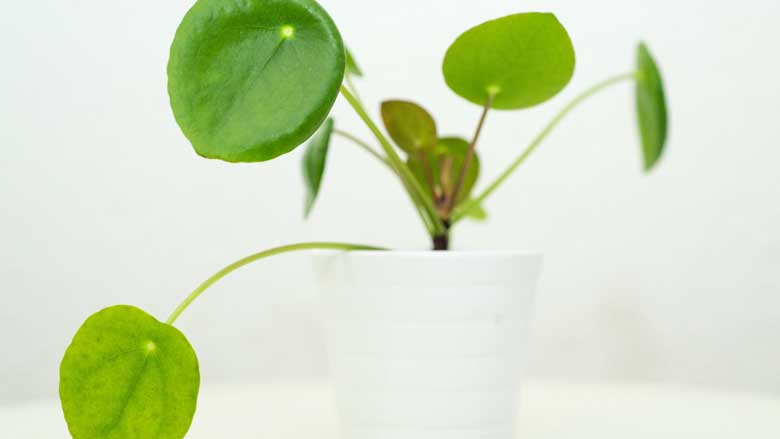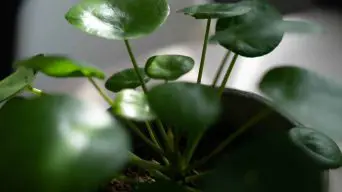Pilea plants are among the most popular houseplants, and for a good reason! They are easy to care for and are known for being drought-tolerant.
There are more than 600 species of Pilea. However, the most common type of Pilea found in households is the Pilea peperomioide plant, the Chinese Money Plant, the Pancake Plant, the Missionary Plant, or the UFO Plant.
While they are low-maintenance plants, you should know a few things about watering a pilea plant to keep it healthy and happy.
The main thing you need to be careful about with Pilea plants is overwatering them.
So, how often should you water a Pilea plant?
This article will guide you on how often to water a Pilea plant and tips on what to do if you think you’re overwatering or underwatering your plant.
How Often Should You Water Pilea Plants
You should water your pilea once weekly, allowing the soil to dry between waterings. You may need to water your plant more frequently if you live in a particularly hot or dry climate. Or, if your home is cooler or has higher humidity, you may only need to water your plant every 10 days.
Staying your finger in the soil is the best indicator of whether your indoor plant needs water. If it feels dry several inches below the surface, it’s time to give your plant a drink.
Several factors can affect how often you need to water your Pilea, including the pot size, the type of potting soil mix, the temperature and humidity of your home, and whether or not the houseplant is in a sunny spot.
Smaller pots will need to be watered more frequently than larger ones. This is because the soil in a small pot dries out more quickly than in a large pot.
The type of potting mix you use can also affect how often you need to water your plant. Heavy clay or peat soil will hold onto moisture longer than sandy soil.
If you’re unsure what potting mix you have, it’s good to check the potting mix label before you water your plant.
Temperature and humidity can also affect how often you water your Pilea. If it’s particularly hot or dry in your home, you may need to water your plant more frequently. Conversely, if it’s cool or humid, you may only need to water your plant every 10 days.
Finally, the location of your plant can affect how often you need to water it. If your plant is in a sunny spot, it will likely need to be watered more frequently than a plant that’s in a shady area.
How Often Should You Water a Pilea in Winter
You should generally water your Pilea plant less often in winter than in summer. This is because the plant is dormant and not growing as quickly.
However, remember a few things when watering your Pilea in winter.
First, the air will be drier in winter than in summer if your home is heated. This can cause the soil to dry quickly, so you may need to water your plant more frequently.
Secondly, when your indoor plant is positioned by a south-facing window, it receives increased sunlight during the winter compared to the summer. This heightened sun exposure can lead to a faster drying of the soil, necessitating more frequent watering for your plant.
Third, if you have a Pilea growing in a pot that’s too small, the roots may be crowded, and the houseplant may need to be watered more frequently.
If you’re unsure how often to water your Pilea in winter, it’s good to check the soil every week. Give your plant a drink if it feels dry several inches below the surface.
How Often Should You Water a Pilea in Summer
You should water your Pilea more often in summer than in winter. The plant is actively growing and needs more water to support its growth.
You may need to water your plant twice a week or more frequently in hot weather. Or, if your home is particularly cool or humid, you may only need to water your plant once a week.
There are a few things to remember when watering your Pilea in summer, as with winter.
First, if your plant is in a pot that’s too small, the roots may be crowded, and the plant may need to be watered more frequently.
Second, if your plant is placed in direct sunlight, it will dry out more quickly than in a bright indirect light or a shady spot where it doesn’t get as much sun.
Third, if the potting mix is heavy in clay or peat, it will hold moisture longer than sandy soil.
If you’re unsure how often to water your Pilea in summer, it’s good to check the soil every few days. Give your plant a drink if it feels dry several inches below the surface.
How Do You Know When Pilea Needs Water?
As mentioned, several factors can affect how often you water your Pilea plant.
Sticking your finger in the soil is the best way to tell if your houseplant needs water. If it feels dry several inches below the surface, it’s time to give your plant a drink.
You can also check the leaves of your plant for signs of stress. If the leaves are drooping or wilting, this is a sign that the plant needs water.
Insufficient water can lead to a loss of color in Pilea leaves. If you observe the leaves transitioning to yellow or brown, it indicates a need for watering in your plant.
If you’re unsure how often to water your Pilea, checking the soil weekly is good. Give your plant a drink if it feels dry several inches below the surface.
It’s also essential to tell when your Pilea is over or underwatered. This can help you determine how often to water your plant.
What Does an Overwatered Pilea Look Like?
Overwatering is one of the most common problems people have with Pilea plants.
If you water your plant too frequently, the roots will rot. This can cause the leaves of your plant to turn yellow or brown.
You may also notice the leaves drooping or wilting if your plant is overwatered. The potting mix may also be soggy or have standing water in it.
If you think your plant is overwatered, taking corrective action is essential.
First, stop watering your plant and allow the soil to dry out.
Once the soil is dry, you can start watering your plant again. However, be sure to water it less frequently than before.
It’s advisable to inspect the drainage capabilities of the potting mix. Inadequate drainage in the potting mix may lead to the development of root rot.
You can add perlite or sand to the potting mix to improve drainage. You can also repot your plant into a pot with drainage holes.
What Does an Underwatered Pilea Look Like?
An underwatered Pilea often has drooping, curling leaves that are wilted and dry to the touch.
The plant may produce fewer leaves, and the lack of water will stunt new growth. In extreme cases, an underwatered Pilea will lose its leaves entirely.
If you think your Pilea is underwatered, the best action is to water it deeply and allow the soil to dry out completely before watering again.
Although it’s tempting to water your Pilea more frequently when it’s underwatered, this can worsen the problem.
Be sure to wait until the soil is dry before watering your plant again. Once the soil is dry, you can water your Pilea deeply and then allow the soil to dry out completely before watering again.
How Long Can a Pilea Go Without Water?
Pilea plants are relatively drought-tolerant and can go for long periods without water.
Most Pilea plants can go for about 2 weeks without water, although some can go even longer.
After 2 weeks, the plant will show signs of stress, such as drooping leaves. However, the plant will usually recover quickly once it’s watered again.
In general, it’s best to err on the side of underwatering rather than overwatering.
If you’re unsure how often to water your Pilea plant, it’s good to check the soil every week. Give your plant a drink if it feels dry several inches below the surface.
How Much Water Does a Pilea Need
When watering Pilea plants, it’s important to water deeply and allow the soil to dry out completely before watering again.
Most Pilea plants need about 1-2 cups of water per week. However, depending on the pot size, potting mix, and climate, some plants may need more or less water.
To water your Pilea, thoroughly water until water runs out of the drainage holes in the bottom of the pot.
After watering, allow the soil to dry out completely before watering again.
If you’re unsure how much water your plant needs, checking the soil every week is a good idea. Give your plant a drink if it feels dry several inches below the surface.
How To Water a Pilea Plant
There are a few different ways to water Pilea plants.
The most important thing is to water deeply and allow the soil to dry out completely before watering again.
You can water your plant using a watering can, hose, or spray bottle.
When watering your plant, be sure to water it at the base of the plant. Avoid getting water on the leaves, as this can cause them to rot.
If you have a small plant, you can water it by submerging the pot in a sink or bowl of water.
Remove the pot from the water after a few minutes and allow any excess moisture to drain out.
It’s also good to use room-temperature water when watering your Pilea. Cold water can shock the roots and cause the leaves to turn brown.
Tap water is fine, but you can use filtered or distilled water if you’re concerned about chemicals.
It’s also a good idea to check the potting mix for drainage. If the potting mix doesn’t drain well, it can cause root rot.
You can add perlite or sand to the potting mix to improve drainage. You can also repot your plant into a pot with drainage holes.
Final Thoughts
How often you should water your pilea depends on several factors.
These include the size of your plant, its pot, the type of soil it is planted in, and your climate.
Generally speaking, you should water your pilea once a week, allowing the top layer of soil to dry between waterings.
However, check your houseplant regularly and adjust your watering schedule as needed.
Watering a pilea plant is vital for keeping it healthy and thriving.
Following the tips in this article, you can ensure that your plant gets the hydration it needs without being overwatered.







